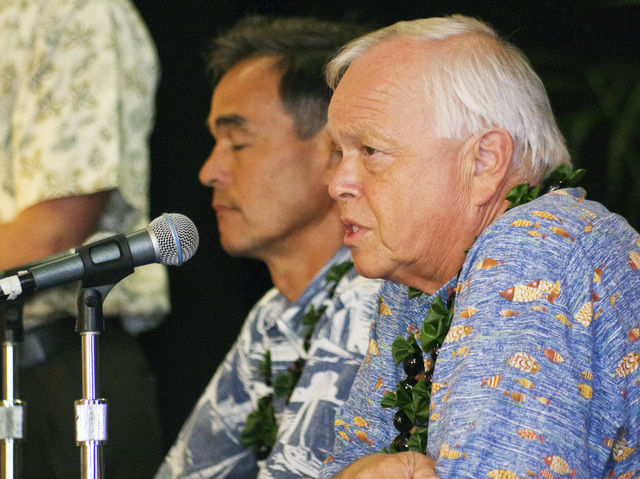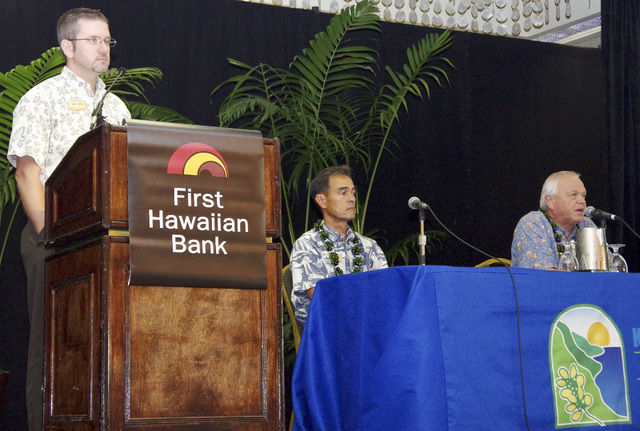Jack Suyderhoud’s offered an encouraging outlook on Kauai’s economy — and a tip — on Thursday.
“My advice is, take advantage of the good times while they last,” he told the crowd of about 200 people at the Kauai Beach Resort.
The professor of business economics was one of two keynote speakers at First Hawaiian Bank’s 41st annual Kauai Business Outlook Forum.
Suyderhoud visited Kauai in July to meet with business owners and leaders, talk to workers and get a ground-level understanding of Kauai’s economy. He liked what he heard and what he saw.
“There is good news about Kauai’s economy,” he said.
He outlined it in a 30-minute presentation.
Construction is doing well, real estate is bouncing back, agriculture is diversifying, the Pacific Missile Range Facility continues to be a dominant economic entity on the Westside ($130 million annual operating budget) and the entertainment industry contributed over $4.8 million in local spending last year.
But, and not surprisingly, he said that more than any other island, Kauai’s economic health hinges on tourism. It’s what drives the resorts, the restaurants and the retailers. It’s what keeps businesses in the black.
“Even some diversified agriculture businesses such as Kauai Coffee and Koloa Rum owe their success to tourism sales,” he said.
Good thing tourism has been thriving here.
Visitors to Kauai totaled about 1.1 million in 2013 and 2014, and that figure is expected to rise to a record 1.2 million this year. And those visitors are spending a lot of money — $1.5 billion last year and it’s on pace to hit $1.6 million this year. Tourism has fueled the improvement in Kauai’s labor market that saw its unemployment rate fall to 3.6 percent.
More guests could be headed here, too. The restoration of the vacant and crumbling Coco Palms resort could begin as early as next year and would add 350 rooms. Two additional condo/timeshares are planned near the Courtyard by Marriott.
There is a drawback to all these people coming to Kauai, Suyderhoud said.
“It is possible for an industry to have too much success,” he said.
Traffic is an ongoing concern, as are potential frictions between tourists and residents at venues with limited space. Likewise, he said “residents are increasingly frustrated with having to expend resources and risk lives rescuing visitors from places they should not go.”
A solution, though, is in the works. The Kauai Tourism Strategic Plan update calls for reducing the impact of tourism on Kauai through several ways, including better infrastructure and management, improved communication between the visitor industry and residents, and increased awareness of the Hawaiian culture.
“Efforts by the county and the industry to provide transportation options such as shuttles could be very helpful,” Suyderhoud said.
Overall, he expects Kauai’s economy to do well through 2015 and into 2016.
He pointed out there was $252 million in construction permits issued on Kauai last year spread among commercial, residential and public projects. This year, private permits have been running more than $10 million per month, compared to less than half that in 2011.
It’s so busy, in fact, he said those wanting construction work done are having a hard time finding contractors willing to do the work.
“Driving around the island confirms activity in all areas,” he said.
There are success stories like Kauai Shrimp, which saw its revenues nearly double to $9 million since 2013 and its workforce increase to 43 full-time employees and up to 60 part-timers and casual hires.
Kauai Shrimp is the third-largest brood stock supplier in the world, with customers in China, Vietnam and India.
“This speaks to the company’s success in a highly competitive industry where price and quality are the determining factors,” Suyderhoud said.
Koloa Rum, he said, is another example “of the synergies between agriculture and tourism.”
The company, which has a new Koloa site in the design stages, employs 24 workers and has sales of about $4 million a year.
There are many signs Kauai’s economy is strong and should remain so into the future as long as tourism holds up, Suyderhoud said in his summary, but he said “diversifying the economic base should continue to be a long-term priority for Kauai.”
Ken Miller, chief investment strategist and director of investment services with First Hawaiian Bank, gave a mostly positive report on expectations for the U.S. and global economic outlook for the rest of this year and next.
He said the U.S. was a “relative bright spot in a lackluster world economy.”
“We are in for a period of sluggish growth. However, I don’t think a global recession is likely,” he said.
John Taylor, Princeville branch manager of First Hawaiian Bank, said the bank has been in business on Kauai more than a century, with its first branch in Waimea. He said many segments of their operations on Kauai are seeing strong growth, too.
“And it’s thanks to each and everyone of you,” Taylor said.






